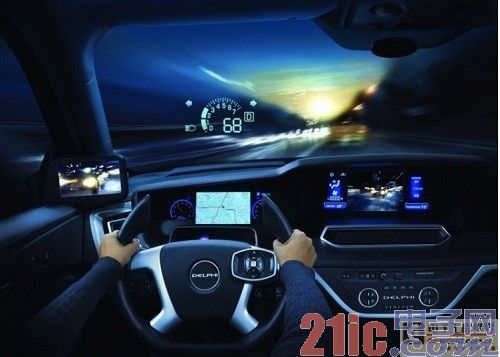Google recently released a self-driving car that is truly its own. It is no longer a prototype of a Lexus car. All control systems are developed by Google. This is a milestone in the field of autonomous vehicles. Not only Google, but also the world's major automakers and parts manufacturers are also working hard to develop relevant technologies.
This article refers to the address: http://
At the 2014 International Automotive Parts Key Technology Forum held on June 5, 2014, Dr. Shen Junqiang, Senior Engineering Manager of Delphi (China) Technology R&D Center, explained the Delphi Automotive Active Safety Technology Solution around the three concepts of safety, green and interconnection. And a vision for autonomous driving.
360° safety barrier around the vehicle
The data shows that 76% of vehicle accidents are caused by driver errors, and the value of driver assistance systems and active safety systems is to help drivers discover these dangers when the driver is not aware of potential accidents, and to warn and control the vehicle. Such means as avoiding accidents or reducing accident losses.
Vehicle accidents are divided into front, side, rear and bicycle accidents. For the front-end collision, Delphi uses video-based intelligent forward-looking system, electronic scanning radar, medium-range radar and radar video integration system (RACam); for side impact, it uses side and rear detection alarm system - RSDS system, In order to avoid the danger of changing lanes when the vehicles change lanes, for rear bumps, the rear view safety can be ensured by the smart rear view camera and the parking assist system. In response to a bicycle accident, Delphi alerted the driver through the lane departure warning LDW.
In addition, Delphi also has a driver fatigue detection system to detect the driver's fatigue status in real time, and remind the driver to stop and rest when appropriate.
Delphi's latest generation of data fusion system, RACam, provides all the capabilities that radar and video systems can provide through a single hardware unit. By arranging multiple radar and video systems on the vehicle, data from multiple radar and video sensors can be combined to provide 360° coverage of the vehicle and provide comprehensive protection for the vehicle.

The basis of an active safety system
We know that any active security system needs to respond to data, and the source of the data is the camera and sensor. As regulations become more stringent (for example, the US NHTSA requires all vehicles to be equipped with rear-view cameras in 2018) and the demand for car safety is increasing, the previous 24 GHz radar is no longer sufficient. Technically speaking, its detection distance is not far enough and the accuracy is not high enough. From the legal level, the government radio management regulations have restrictions on the 24 GHz band. It is not a vehicle radar frequency approved by all governments. In response to these limitations, all of Delphi's active safety systems use radar between the 76GHz and 77GHz bands.
And for "After installing RACam on the windshield, will it weaken the signal?" "Is there more energy loss than installing on the bumper?" Dr. Shen Junqiang pointed out: "The windshield weakening signal is indeed better than the bumper material. Slightly larger. Take the RAcam system as an example, the compensation will be made in the design stage, so that the radar installed behind the windshield has the same detection capability as the radar at the bumper."
The original intention of system design
1) Avoid all kinds of accidents
According to Dr. Shen Junqiang, the development of Delphi's active safety system is based on the causes of various frequent traffic accidents. It is considered to be the most beneficial to reduce certain types of traffic accidents. For example, the forward collision warning system can reduce 21% of rear-end collisions and lane departure warnings can reduce accidents caused by road deviations by 21%-23%. Reversing and parking assist systems can greatly improve the safety of the vehicle during reverse and parking.
2) Reduce costs
Active safety systems have been developed to the present, mainly in luxury cars or mid- to high-end cars. Although there is a trend of gradual decline, cost is still one of the factors hindering its development. In this regard, Delphi's principle of matching functional requirements with technical capabilities optimizes cost and function coordination.
3) Towards autonomous driving
The various types of systems mentioned above are designed to improve road safety and reduce driver driving pressure. And this is the process of moving towards autonomous driving. Dr. Shen Junqiang said that Delphi is currently in the middle stage of autonomous driving, and automatic driving is the ultimate goal of active safety systems.
In the future, the development of Delphi's active safety technology will focus on the development of existing systems, adopting new sensors and system architecture as the focus of research and development, achieving true 360° coverage around the body, and the related systems will be mass-produced by the end of 2016.
To achieve automatic driving, V2V/V2I communication, cloud platform control and other means will be introduced. Delphi expects to achieve mass production of related systems by 2025.
Recessed Swimming Pool Light,Led Underwater Lights,Led Underground Lights,Pool Underground Lights
SHENGYA LIGHTING TECHNOLOGY CO., LTD. , https://www.syalighting.com